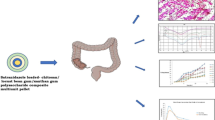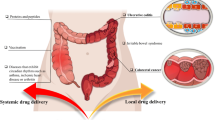Abstract
Background and Objectives
Oral colon-targeted gel beads containing isoliquiritigenin (ISL) were successfully designed in our study. In order to further explore the targeting of the colon by the gel beads, a systematic study of their in vivo pharmacokinetics and colon targeting was performed in mice.
Methods
Eighteen male mice were included in this study. The mice were separated into six groups at random. We collected blood, stomach, duodenum, jejunum, ileum, and colon tissues at 2, 4, 6, 8, 12, and 24 h after oral administration of gel beads containing isoliquiritigenin at a dose of 20 mg/kg. Gel beads in tissues were recorded and taken out to observe their swelling and erosion. The total ISL concentrations in different tissues and gel beads were analyzed by high-performance liquid chromatography.
Results
All gel beads reached the upper part of the stomach at 2 h with no obvious swelling. Most of the gel beads were still in the lower part of stomach, while a small amount had reached the small intestine at 4 h. A few gel beads reached the colon and swelled at 6 h. Furthermore, the gel beads in the colon were swollen and erosive at 8 h. Meanwhile, the plasma ISL concentration could be detected, which indicated that the ISL in the gel beads was absorbed. At 12 h, the gel beads were almost dissolved and the plasma concentration was 8.33 times that at 8 h. At 24 h, the gel beads had completely disappeared, and the plasma concentration was 2.55 times that at 12 h.
Conclusion
The gel beads containing ISL are a sustained, controlled, and colon-targeting delivery system that can alter the ISL distribution in the gastrointestinal tract.





Similar content being viewed by others
References
Pinto JF. Site-specific drug delivery systems within the gastro-intestinal tract: from the mouth to the colon. Int J Pharm. 2010;395(1–2):44–52. https://doi.org/10.1016/j.ijpharm.2010.05.003.
Philip AK, Philip B. Colon targeted drug delivery systems: a review on primary and novel approaches. Oman Med J. 2010;25(2):79–87. https://doi.org/10.1016/j.jddst.2021.102579.
Liu Y, Sun Y, Sun L, Rizwan ur R, Wang Y. In vitro and in vivo study of sodium polyacrylate grafted alginate as microcapsule matrix for live probiotic delivery. J Funct Foods. 2016;24:429–37. https://doi.org/10.1016/j.jff.2016.03.034.
Haffner FB, van de Wiele T, Pasc A. Original behavior of L. rhamnosus GG encapsulated in freeze-dried alginate-silica microparticles revealed under simulated gastrointestinal conditions. J Mater Chem B. 2017;5(38):7839–47. https://doi.org/10.1039/c7tb02190a.
Iqbal R, Zahoor T, Huma N, Jamil A, Unlu G. In-vitro GIT tolerance of microencapsulated Bifidobacterium bifidum ATCC 35914 using polysaccharide-protein matrix. Probiotics Antimicrob Proteins. 2019;11(3):830–9. https://doi.org/10.1007/s12602-017-9384-5.
Feng K, Wei YS, Hu TG, Linhardt RJ, Zong MH, Wu H. Colon-targeted delivery systems for nutraceuticals: a review of current vehicles, evaluation methods and future prospects. Trends Food Sci Technol. 2020;102:203–22. https://doi.org/10.1016/j.tifs.2020.05.019.
Zhang XY, Qiao H, Ni JM, Shi YB, Qiang Y. Preparation of isoliquiritigenin-loaded nanostructured lipid carrier and the in vivo evaluation in tumor-bearing mice. Eur J Pharm Sci. 2013;49:411–22. https://doi.org/10.1016/j.ejps.2013.04.020.
Gong H, Zhang BK, Yan M, Fang PF, Li HD, Hu CP, Yang Y, Cao P, Jiang P, Fan XR. A protective mechanism of licorice (Glycyrrhiza uralensis): isoliquiritigenin stimulates detoxification system via Nrf2 activation. J Ethnopharmacol. 2015;162:134–9. https://doi.org/10.1016/j.jep.2014.12.043.
Link P, Wink M. Isoliquiritigenin exerts antioxidant activity in Caenorhabditis elegans via insulin-like signaling pathway and SKN-1. Phytomedicine. 2019;55:119–24. https://doi.org/10.1016/j.phymed.2018.07.004.
Chen X, Cai X, Le R, Zhang M, Gu X, Shen F, Hong G, Chen Z. Isoliquiritigenin protects against sepsis-induced lung and liver injury by reducing inflammatory responses. Biochem Biophys Res Commun. 2018;496(2):245–52. https://doi.org/10.1016/j.bbrc.2017.11.159.
Yang EJ, Kim M, Woo JE, Lee T, Jung JW, Song KS. The comparison of neuroprotective effects of isoliquiritigenin and its phase I metabolites against glutamate-induced HT22 cell death. Bioorg Med Chem Lett. 2016;26(23):5639–43. https://doi.org/10.1016/j.bmcl.2016.10.072.
Mahalingam S, Gao L, Eisner J, Helferich W, Flaws JA. Effects of isoliquiritigenin on ovarian antral follicle growth and steroidogenesis. Reprod Toxicol. 2016;66:107–14. https://doi.org/10.1016/j.reprotox.2016.10.004.
Wang TT, Chen ZZ, Xie P, Zhang WJ, Du MY, Liu YT, Zhu HY, Guo YS. Isoliquiritigenin suppresses the proliferation and induced apoptosis via miR-32/LATS2/Wnt in nasopharyngeal carcinoma. Eur J Pharmacol. 2019;856: 172352. https://doi.org/10.1016/j.ejphar.2019.04.033.
Qiao H, Zhang X, Wang T, Liang L, Chang W, Xia H. Pharmacokinetics, biodistribution and bioavailability of isoliquiritigenin after intravenous and oral administration. Pharm Biol. 2014;52(2):228–36. https://doi.org/10.3109/13880209.2013.832334.
Zhang X, Qiao H, Zhang T, Shi Y, Ni J. Enhancement of gastrointestinal absorption of isoliquiritigenin by nanostructured lipid carrier. Adv Powder Technol. 2014;25(3):1060–8. https://doi.org/10.1016/j.apt.2014.02.012.
Zhao QQ, Zhang XY, Tang XF, Qiao H. A novel and oral colon targeted isoliquiritigenin delivery system: development, optimization, characterization and in vitro evaluation. J Drug Deliv Sci Technol. 2021;66:102777. https://doi.org/10.1016/j.jddst.2021.102777.
Wang H, Gong X, Guo X, Liu C, Fan YY, Zhang J, et al. Characterization, release, and antioxidant activity of curcumin-loaded sodium alginate/ZnO hydrogel beads. Int J Biol Macromol. 2019;121:1118–25. https://doi.org/10.1016/j.ijbiomac.2018.10.121.
Shen MY, Liu TI, Yu TW, Kv R, Chiang WH, Tsai YC, Chen HH, Lin SC, Chiu HC. Hierarchically targetable polysaccharide-coated solid lipid nanoparticles as an oral chemo/thermotherapy delivery system for local treatment of colon cancer. Biomaterials. 2019;197:86–100. https://doi.org/10.1016/j.biomaterials.2019.01.019.
Zhang B, Yan Y, Shen Q, Ma D, Huang L, Cai X, Tan S. A colon targeted drug delivery system based on alginate modificated graphene oxide for colorectal liver metastasis. Mater Sci Eng C Mater Biol Appl. 2017;79:185–90. https://doi.org/10.1016/j.msec.2017.05.054.
Wang QS, Wang GF, Zhou J, Gao LN, Cui YL. Colon targeted oral drug delivery system based on alginate-chitosan microspheres loaded with icariin in the treatment of ulcerative colitis. Int J Pharm. 2016;515(1–2):176–85. https://doi.org/10.1016/j.ijpharm.2016.10.002.
Fatemeh A, Sayeh M, Maryam I, Masoud S, Farid D. In vitro evaluation and modification of pectinate gel beads containing trimethyl chitosan, as a multi-particulate system for delivery of water-soluble macromolecules to colon. Carbohyd Polym. 2005;61:39–51. https://doi.org/10.1016/j.carbpol.2005.02.005.
Sookkasem A, Chatpun S, Yuenyongsawad S, et al. Alginate beads for colon specific delivery of self-emulsifying curcumin. J Drug Deliv Sci Technol. 2015;29:159–66. https://doi.org/10.1016/j.jddst.2015.07.005.
Lee T, Yoon HC. Structural, physicochemical, and in-vitro release properties of hydrogel beads produced by oligochitosan and de-esterified pectin from yuzu (Citrus junos) peel as a quercetin delivery system for colon target. Food Hydrocoll. 2020;108:106086. https://doi.org/10.1016/j.foodhyd.2020.106086.
Kumar, Ankit, Monica G, Sachin KS, K. G, Rahul P, et al. Effect of co-administration of probiotics with guar gum, pectin and eudragit S100 based colon targeted mini tablets containing 5-fluorouracil for site specific release. J Drug Delivery Sci Technol. 2020;60:102004. https://doi.org/10.1016/j.jddst.2020.102004.
Author information
Authors and Affiliations
Corresponding author
Ethics declarations
Funding
No source of funding.
Conflict of Interest
The authors declare no confict of interest. The authors alone are responsible for the content and writing of this article.
Ethics Approval
The study was approved by Lanzhou University's Animal Ethics Committee. All institutional and national guidelines for the care of the laboratory animals were followed.
Consent to Participate
Not applicable.
Consent for Publication
Not applicable.
Data Availability
All data are included in the manuscript.
Code Availability
Not applicable.
Author Contributions
All authors contributed to the study conception and design. The manuscript was designed, written, and revised by XZ. The experiments and the statistical data analysis reported in the manuscript were mainly completed by XT and QZ. All the authors read the final version of the manuscript.
Rights and permissions
About this article
Cite this article
Tang, X., Zhang, X. & Zhao, Q. A pH/Time/Pectinase-Dependent Oral Colon-Targeted System Containing Isoliquiritigenin: Pharmacokinetics and Colon Targeting Evaluation in Mice. Eur J Drug Metab Pharmacokinet 47, 677–686 (2022). https://doi.org/10.1007/s13318-022-00783-8
Accepted:
Published:
Issue Date:
DOI: https://doi.org/10.1007/s13318-022-00783-8




